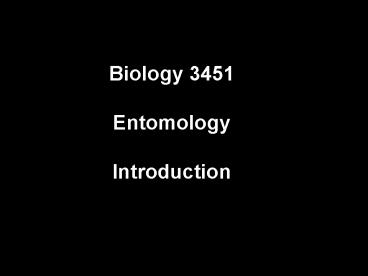Biology 3451 - PowerPoint PPT Presentation
1 / 27
Title:
Biology 3451
Description:
'American Entomology' History of Entomology. P.F.M.A. Dejean (1780 - 1845) ... Crustacea (crabs, lobsters, barnacles) Pauropoda. Diplopoda (millipedes) ... – PowerPoint PPT presentation
Number of Views:55
Avg rating:3.0/5.0
Title: Biology 3451
1
Biology 3451 Entomology Introduction
2
How the course is organized
Part 1 Guts n Gonads
Internal and External Structure
1. All major body sections associated appendages
2. All major organ systems and how they work.
Part 2 Tiptoe through the Orders
1. Insect evolution and paleontology
2. Characteristics of the insect orders and how
they are related
Part 3 Assorted and Fascinating Topics
- such as communication, overwintering
strategies, mating systems, forensic entomology
3
Why we care about insects.
1. Annoyance/Disease
2. Competition
3. Providers
4. Fascination
5. Mythology
4
History of Entomology
Eygptian Mythology - scarab (dung ) beetle
Prenomens of Pharaohs
5
History of Entomology
Aristotle (384 - 322 BC)
History of the Animals
On the Parts of Animals
On the Generation of Animals
Contributions
1. Observations on behaviour/natural history
2. First attempt at taxonomy
3. Applied entomology (pest control)
4. Recognized metamorphosis
6
History of Entomology
Pliny the Elder (23 - 79 AD)
Historica Naturalis
7
History of Entomology
Albertus Magnus (1193 - 1280 )
De Animalibus -covered 33 insect species
8
History of Entomology
Marcello Malpighi (1628 - 1694)
-published first detailed anatomy of any
invertebrate (Bombyx)
9
History of Entomology
Anton van Leeuwenhoek (1632 - 1723)
- microscopy
- described viviparity and parthenogensis in
aphids
10
History of Entomology
Jan Swammerdam (1637 - 1680) (Father of
Entomology)
-microanatomical studies (mayfly, honeybee)
11
History of Entomology
John Ray (1628 - 1705)
-scheme for classification of all living things
(including insects)
12
History of Entomology
Carl von Linné ( 1707 - 1778) (Linnaeus)
- binomial classification system
- described over 2000 species of insects
13
History of Entomology
J.C. Fabricius (1745 - 1808)
- student of Linnaeus
- classified insects based on mouthparts
Systema Entomologica (1775) -basis of insect
classification Philosophia Entomologica
(1778) -first entomology text - described
gt10,000 species
14
History of Entomology
Thomas Say (1787 - 1834)
-wrote first treatise on insects in North
America American Entomology
15
History of Entomology
P.F.M.A. Dejean (1780 - 1845)
-first to specialize on one group of insects -
described gt22,000 species of beetles
16
History of Entomology
Aristotle
Pliny the Elder
Albertus Magnus
400 300 200 100 0 100
1100 1200 1300
Invention of microscope
Swammerdam
Von Leeuwenhoek
Say
Ray
Fabricius
Malpighi
Linnaeus
1500 1600 1700 1800 1900
17
PHYLOGENY
Hexapoda
Crustacea (crabs, lobsters, barnacles)
Pauropoda
Diplopoda (millipedes)
Myriapoda
Chilopoda (centipedes)
Arthropoda
Symphyla
Arachnida (spiders, mites, ticks)
Eurypterida (sea scorpions)
Chelicerata
Xiphosura (horseshoe crabs)
Pycnogonida (sea spiders)
Trilobita (trilobites)
18
PHYLOGENY
Hexapoda
Crustacea (crabs, lobsters, barnacles)
Pauropoda
Diplopoda (millipedes)
Myriapoda
Chilopoda (centipedes)
Arthropoda
Symphyla
Arachnida (spiders, mites, ticks)
Eurypterida (sea scorpions)
Chelicerata
Xiphosura (horseshoe crabs)
Pycnogonida (sea spiders)
Trilobita (trilobites)
19
The Insect Orders
Collembola
Protura
Hexapoda
Diplura
Insecta
20
The Insect Orders
Archaeognatha
Insecta
Thysanura
Ephemeroptera
Paleoptera
Odonata
Pterygota
Plecoptera
Embiidina
Orthopteroids
Phasmida
Orthoptera
Mantophasmatodea
Zoraptera
Dictyoptera
Grylloblatodea
Neoptera
Hemipteroids
Psocodea
Thysanoptera
Hemiptera
Endopterygota
21
The Insect Orders (continued
Archaeognatha
Insecta
Thysanura
Paleoptera
Orthopteroids
Megaloptera
Pterygota
Rhaphidioptera
Neuroptera
Neoptera
Hemipteroids
Coleoptera
?
Strepsiptera
Endopterygota
Diptera
Mecoptera
Siphonaptera
Trichoptera
Lepidoptera
Hymenoptera
22
Animal Abundance - Number of Species
23
Relative Abundance of the Major Insect Divisions
From the phylogenetic tree Endopterygota
Coleopteroids Strepsiptera Lepidopteroids
Dipteroids Hymenoptera Exopterygota
Hemipteroids Paleoptera Orthopteroids Aptery
gota Thysanura Archaeognatha
24
Insect Orders - Number of Species
25
Insect Orders - Number of Species (log plot)
26
WHY ARE INSECTS SO SUCCESSFUL?
1. Ability to fly
2. Reproductive capacity adaptibility
3. Resist drying - exoskeleton
4. Small size
5. Metamorphosis
27
Next time Why insects are crunchy!































